They say… 
Best beer and travel writing award 2015, 2011 -- British Guild of Beer Writers Awards
Accredited Beer Sommelier
Writer of "Probably the best book about beer in London" - Londonist
"A necessity if you're a beer geek travelling to London town" - Beer Advocate
"A joy to read" - Roger Protz
"Very authoritative" - Tim Webb.
"One of the top beer writers in the UK" - Mark Dredge.
"A beer guru" - Popbitch.

|
British Real Ale in a Bottle May 2010
ABV: 5%
Origin: Crockham Hill, Kent, England
Website: www.westerhambrewery.co.uk
 Westerham National Trust Viceroy India Pale Ale This beer featured as a British Real Ale in a Bottle on the bottled beer review page in the May 2010 issue of BEER magazine, sent free every quarter to CAMRA members, who can also view it online. The magazine is also available in selected newsagents.
This issue’s selection of beers is a “mixed case”, as I’ve tasted so much good Real Ale in a Bottle over the past few months that doesn’t fit easily into a theme. If these English bottle conditioned beers have anything in common other than their quality, it’s that they’re all from small local breweries with a sense of place.
Westerham National Trust Viceroy IPA (5 per cent) is the first National Trust-branded beer that uses malt and hops from Trust sources including organic Target and Progress from Scotney Castle and organic Westminster pale malt. It’s supplied by Westerham brewery, itself founded in 2004 on a Trust-owned farm in the Weald of Kent, and commemorates sometime Viceroy of India George Curzon (1859-1925) who restored the Taj Mahal as well as donating several properties to the Trust. On the mild side for a revivalist India Pale Ale, it still has plenty of earthy, resiny hops and a good malt base.
This is an prange-amber beer with a pinkish white head and a boiled fruit and sweet malt arroma with a mineral hint. The tart but malty and sweetish palate has earthy resiny hops, cadied fruit and slightly odd sulphur notes. Drying herbs develop to usher in a sweetish malty finish with rhubarb tartness and lightly peppery hops, with a slightly cloying quality, but overall a decent beer easily worthy of its august branding.
Buy this beer from AlesbyMail.com as part of a special pack containing all the beers featured on my beer review page in BEER this month. BEER readers receive a special discount by entering the voucher code shown in the magazine.
To download BEER if you’re a CAMRA member, see http://www.camra.org.uk/page.aspx?o=beer.
To find out more about CAMRA membership, see http://www.camra.org.uk/page.aspx?o=joinus.
For more beers featured in this article, see next post.
Read more about this beer at ratebeer.com: http://www.ratebeer.com/beer/westerham-national-trust-viceroy-india-pale-ale/108670/
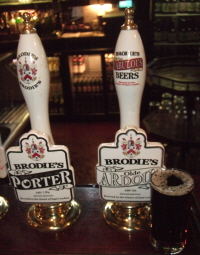 Handpumps in the King William IV, Leyton, London E10 London is the crucible of industrial brewing, the birthplace of several key world beer styles and the capital of one of the world’s greatest brewing nations, but in the last few years its brewing activity had been starting to look embarassingly sparse. Young’s and Pitfield relocated, numerous micros went under, and even the historic Stag brewery at Mortlake, latterly home to the British version of American “Bud”, was rationalised out of existence. For a while it seemed only Fuller’s, Meantime, tiny Twickenham and a brace of stylish brewpubs were still firing up the mash tuns within the 33 London boroughs. But now it appears that London brewers are bouncing back — over the past 18 months three strong new micros have emerged, and their products are already impressive. Sambrook’s opened in Battersea, SW11, in summer 2008; about the same time the Brodie family revived brewing at their Leyton, E10, pub the King William IV, formerly home to the Sweet William brewery; and since the beginning of the year the beer has been flowing from Redemption in Tottenham, N17. There’s also news from Bermondsey, SE1, of the newly started Kernel brewery.
This resurgence saw London beers making an appropriately strong showing at this year’s London Drinker Beer Festival in early March. I even bumped into two of the prime movers of the revival, Duncan Sambrook and Redemption’s Andy Moffat, chatting together over pints of each other’s brews in the friendly manner that’s customary for commercial rivals in this industry of enthusiasts. Both are doing well, with Sambrook’s expanding production and Redemption bathing in early praise from drinkers.
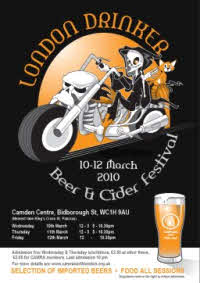 London Drinker Beer Festival 2010 The future of the festival itself, however, is less certain, with news that its longstanding venue, the Camden Centre, a large council-owned theatre-style meeting hall round the back of Camden Town Hall, will either undergo major refurbishment or close for good in the next year. At the moment, the Drinker is the most central of CAMRA’s London festivals and probably one of the most well-connected of all festivals — it’s right opposite Kings Cross and St Pancras with Euston just down the road, so you could have lunch in Manchester, Sheffield, Leeds, Brussels or Paris and still be here for the evening session. Unsurprisingly the festival’s annual branding takes a transport theme — this year, in anticipation of its likely demise, the posters and glasses featured Death on a mean-looking motorbike.
Which is a shame, as the Drinker, actually organised by North London CAMRA and not directly connected to the regional free magazine of the same name, is a friendly festival with much going for it. As well as the fine range of beers, focusing on London and surrounding counties but with great choices from all over the UK too, plus a well-stocked imported beer bar that’s strong on German draughts, it’s also one of the few to offer its own simple but wholesome food, home-cooked by volunteers, with decent vege options including the celebrated mushroom and beer pâté. The disadvantage of centrality is that it soon becomes very busy, with only a handful of chairs in a main space that gets packed with standing drinkers. Then there’s the odd quirk of keeping old-fashioned pub hours, with lunchtime and evening sessions and an afternoon closure, and the fact that it hasn’t yet progressed to making beer available in thirds, but if it really does fall foul of Death on a Bike due to venue problems, it’ll be a loss to London’s drinkers.
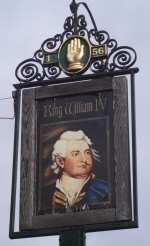 King William IV, Leyton High Road, London E10 The last weekend in March saw further evidence of London’s re-emergence as a brewing city with Brodie’s showcasing around 20 of their own beers at their Leyton headquarters under the banner of the Bunny Basher Easter Beer Festival. For some reason I’d not yet got around to trekking out to the William so this was a great reason to go. It’s a sprawling landmark corner pub on Leyton High Road, on a site long associated with the licensed trade, though the present building largely dates from an 1891 rebuilding, with a quirkily traditional interior now divided into two big bars. The pub is one of three in London long owned by Brian Brodie, and from 2000-2005 someone else ran a brewery known as Sweet William in outbuildings across the yard. The brewery was then abandoned until 2008, when Brian’s son and daughter, former home brewers James and Lizzie, restored it, relaunching as Brodie’s Beers.
Brodie’s cover a huge variety of styles, many of them inspired by London brewing traditions, and what’s impressive is that they make a good fist of nearly all of them despite the relative newness of the brewery. The offerings at the festival included British and American style IPAs, bitters, porters, the excellent regular mild, various stouts including a Jamaican-inspired session stout and an imperial, a blueberry wheat beer, a dry brown ale and a golden ale featuring Amarillo hops, the name gender-changed to Amarilla after the London pronunciation. Most remarkably, all were on sale at the pub’s standard £1.99 a pint, even the 12% Romanov Empress imperial stout!
The London Drinker may have drained its last firkin, but there’s clearly still plenty of London worth drinking.
Selected tastings
London Beer Tastings 2011, London Drinker Beer Festival March 2010
A shorter version of this review was first published in BEER February 2010 as part of a piece about beers to taste with chocolate. For more beers tasted with chocolate, see Rulles JeanChris Numéro 1.
ABV: 4.2%
Origin: London SW11, England
Website: www.sambrooksbrewery.co.uk
 Sambrook's Wandle JeanChris No 1(reviewed in the previous post) is rare in the UK, but as it has something of the character of a British bitter, you could find alternatives closer to home. For example Sambrook’s Wandle), an impressive, tasty bitter available both bottle conditioned, as reviewed here, and in cask (at the lower gravity of 3.8%) from new southwest London micro Sambrook’s, founded by Duncan Sambrook in Battersea in 2008. Duncan was inspired partly by the decline in brewing in London marked by the departure of Young’s to Bedford, alluded to in the beer’s name, Wandle – the river that runs into the Thames past the Young’s brewery site.
The beer is a classic amber colour with a fine yellowy head and a gently malty spicy aroma which is very slightly wheaty and phenolic. A fresh well-balanced malty palate has a slight banana note and a seedy hop tangy. The soft finish has strawberry fruit and a gentle hoppy was developing peppery tones from Fuggles, Goldings and Boadicea. The flavour complements the fruitiness of good chocolate, which in turn brings out spicy orange notes in the beer.
Afterword November 2011. Although bottled beers are an important part of Sambrook’s business plan, the majority of its beer goes out in cask, and in this form Wandle does brilliantly in the role of draught session beer.
A sample tasted at the Willoughby Arms in Kingston late in 2010 was warm amber, with a fine white head and a dry and lightly citric aroma. The palate was notably luscious given the relatively low gravity, with waxy fruit and nuts and hints of artichoke. A lightly dry, cewy, soothing finish was only moderately long but very pleasant and moreish. I suspect the strawberry notes found in the bottled version were an artifact of the bottling yeast.
For more beers tasted with chocolate see Elmtree Nightlight Mild.
Read more about this beer at ratebeer.com: http://www.ratebeer.com/beer/sambrooks-wandle/98632/
London Drinker Beer Festival March 2010
ABV: 4.6%
Origin: London N17, England
Website: http://urbanbrewer.blogspot.com/
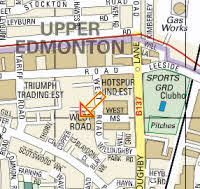 Redemption Brewery, London N17 0XL Andy Moffat’s Redemption Brewery in Edmonton is about as new generation as new generation London brewers can get, having first entered revenue earning service in January this year (2010). A former City bond trader and home brewer, Andy opted for a mid-life career change last autumn, investing in a plant that was formerly at Slaters in Stafford. This is one of his two launch beers, both of which have made an excellent impression on local drinkers and are already fixtures in a few pubs.
The poetically named Urban Dusk, a chestnut brown hybrid that teeters between a strongish mild and a dark bitter, was on tap at the Wenlock Arms in Islington when I hosted a beer tasting there in February, and nearly everyone attending was on the stuff when they weren’t sampling my bottles. It was also to be enjoyed alongside the products of several other new London micros at the London Drinker beer festival in early March.
My sample came with a slight bubbly white head and a leafy and slightly artichokey chocolate and fruit aroma. A sweetish fruity finish had a bite of roast giving an edge to nutty sappy malt, with more artichokes. Herbs and brown sugar rounded out a tangy, chewy finish to a very tasty and very promising beer with a very individual character.
Read more about this beer at ratebeer.com: http://www.ratebeer.com/beer/redemption-urban-dusk/118539/
London Drinker Beer Festival March 2010
ABV: 5%
Origin: South Woodham Ferrers, Essex, England
Website: http://www.crouchvale.co.uk/
 Crouch Vale Amarillo Beer blogger Mark Dredge, of Pencil & Spoon fame, pointed me in the direction of this fine hoppy golden ale at the London Drinker beer festival. From one of Britain’s oldest and most respected new generation micros (founded in 1981), it makes a great feature of the distinctively fruity US hop variety from which it takes its name.
My sample was a rich gold with very little head and a rich, almost whiskyish aroma, with floral and fruity notes that brought to mind Lucozade and apricots. There were more apricots on a full hoppy palate with a slightly herbal bitterness, a touch of burry hopsack and very full bodied malt that made the beer taste a percentage or two higher in ABV than it actually is. Citric orange and lime notes came to the fore on the swallow, with a long, tingling orange and apricot finish that eventually became firmly peppery-bitter, with plenty of balancing malt and fruit and none of the harshness some of the newer hoppy beers exhibit.
Read more about this beer at ratebeer.com: http://www.ratebeer.com/beer/crouch-vale-amarillo/24922/
London Drinker and Brodie’s Bunny Basher Beer Festivals March 2010
ABV: 12.1%
Origin: London E10, England
Website: www.brodiesbeers.co.uk
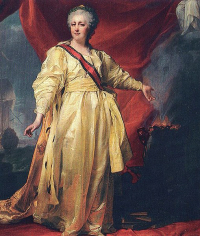 Catherine II The Great (Екатерина II Великая, 1729-96), Empress and Autocrat of All the Russias, by D G Levitsky c1770 The Brodies only revived brewing at the King William IV in Leyton a year and a half ago but already they’re producing a large range of solidly impressive beers. This is currently their strongest and one of their most accomplished — a big Imperial Stout based on a 19th century recipe and named with reference to Empress Catherine the Great of Russia, in fact born a German aristocrat but who ruled Russia when the eponymous William was born, and oversaw the importation of British strong stouts into her empire.
I happened on a bottled version at the Pigs Ear beer festival in December 2009, mistakenly listed as Romanov Express, which sounds like the name of a very romantic train. This was a mahogany-black beer with a fine deep orangey beige head and a chocolate, cofffee and raisin aroma with notes of grapes and smoky roast. The rich strong chocolate palate had grape and blackcurrant coffee flavours and varnish notes, turning tart and mouth-numbering with a restrained roasty quality. A dryer finish became more definitively roasty, with concentrated cocoa and a fruity, viny slick. Although complex, the flavour was a bit close and slow developing, and the beer will almost certainly spread and relax with a little bottle age.
In the brewpub itself for its Easter beer festival, I couldn’t resist sampling Romanov Empress again, this time on draught — particularly since it was on sale at the standard price of all the draught beers. It’s not often that a beer of over 12% is sold at £1 for a half pint. This version was jet black, with a lovely creamy cappucino-like beige head, and a toffee and liquorice aroma. This time the fruity notes brought to mind blackcurrant and blueberry, and there were toffee and spirits too, leading to a thick, rich, sweetish and very fruity toffee palate with a slightly medicinal edge and malt cake. A toffee apple note on the swallow led to a long, slick, warming finish with emerging relatively gentle roast, and a lightly oxidised minty quality. Again a very complex beer, rather sweet but beautifully balanced, and worth at least five times its listed price.
Read more about this beer at ratebeer.com: http://www.ratebeer.com/beer/brodies-romanov-empress-stout/114717/
First published in BEER December 2006 as part of a page about strong beers. See previous post for more strong beers.
ABV: 8.5 per cent
Origin: Stockport, Manchester, England
Website: www.frederic-robinson.co.uk
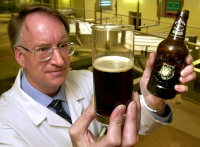 Robinson's head brewer Chris Hellin with Old Tom Strong Ale. Photo: Tony Carter. The Unicorn brewery, in the former hat-making town of Stockport on the suburban fringe of Greater Manchester, began as a pub owned by the Robinson family which started brewing in 1865.
Robinson’s is now one of Britain’s biggest regionals, with an extensive tied estate and a big 1920s red brick brewery complex that contract brews and bottles alongside producing its own brands.
However it’s still family owned and traditionally minded enough to find room for beers like Old Tom in its portfolio. This barley wine with old ale tendencies allegedly gained its name when a brewer annotated a notebook entry with a sketch of the brewery cat back in 1899.
Despite potentially malodorous connotations, both the name and the beer have stuck around. It’s now being marketed afresh, with stylish new embossed bottles popping up in supermarkets a long way from Stockport.
Old Tom is brewed from British pale and crystal malt, touches of chocolate malt and caramel, and Goldings whole hops with a little Northdown; it’s then dry hopped with Goldings pellets during conditioning.
The resulting beer is deep ruby brown with a bubbly, rapidly subsiding head. The cakey aroma has burst of sweetish esters with hints of cherry and marzipan.
A rich palate boasts vine fruits, almonds and sherry, sweetish but well-balanced with a slightly woody dryness and nutty hops. A warming swallow leads to a port-like finish with ripe fruit, rooty hops and more wood.
Old Tom also pops up on draught, in which form it won Champion Winter Beer of Britain in 2005. The bottled version is not bottle conditioned, but is still brimming with quality, tradition and character, and a worthy addition to the supermarket trolley.
Read more about this beer at ratebeer.com: http://www.ratebeer.com/beer/robinsons-old-tom-bottle/16872/
First published in BEER December 2006 as part of a page about strong beers. See previous post for more strong beers.
ABV: 8.5 per cent
Origin: Terrick, Buckinghamshire, England
Website: www.chilternbrewery.co.uk
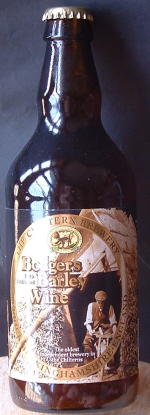 Chiltern Bodgers Barley Wine Launched in 1980 and still run by the Jenkinson family, the Chiltern Brewery near Aylesbury is a rare survivor from the first wave of new micros. As well as brewing beer the company makes and sell a wide range of beer-related products, from Terrick Truckle beer cheese to hop scented cologne.
But its most renowned product is this notable bottle conditioned barley wine, with sepia tinted labels showing a local bodger – a craftsperson who makes chairs and other items from greenwood poles – at work in the 1920s.
A pure pale malt grist results in a rich golden-amber colour, which in my sample poured slightly hazy with a bubbly white head. Challenger, Fuggles and Goldings provide the hop character.
The complex aroma has notes of plummy fruit, olives, coal tar soap and rich malt. The luxuriously malty palate turns beautifully aromatic in the mouth, with phenol, petrol, liqueur marmalade and chewy hops.
The drying finish is lightly bitterish and slightly mouth numbing with chewy orange notes and a touch of mint.
Bodgers demonstrates that strong British beers don’t have to be dark and brooding: it’s essentially a bitter racked up several degrees in strength and complexity, with much to reward the attentive sipper but preserving its drinkability to perilous effect.
One minor niggle is the 500ml bottle which is far too big for a beer of this strength: it deserves a smaller and more elegant package.
NOTE: Partly prompted by this review, the beer has since been made available in smaller bottles.
See next post for more strong beers.
Read more about this beer at ratebeer.com: http://www.ratebeer.com/beer/chiltern-bodgers-barley-wine/13164/
First published in BEER December 2006 as part of a page about strong beers.
ABV: 8.7 and 11 per cent
Origin: Market Weston, Suffolk, England
Website: http://www.oldchimneysbrewery.com/
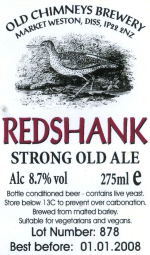 Old Chimneys Redshank Strong Old Ale With the nights drawing in, the weather – at least in theory – getting colder and the festive season approaching, I’m turning this month to the strong specialities – the sort of beers that bear up well to being sipped and savoured late in the evening while relaxing in front of a roaring radiator.
Former Greene King and Broughton brewer Alan Thomson of Old Chimneys has made something of a speciality of unusual and strong real ales in a bottle, hand-crafted near Diss on the Norfolk-Suffolk border with vegetarian-friendly ingredients.
Redshank, a strong old ale named after a red legged wading bird found on nearby wetlands, is created from Fuggles and Challenger hops with crystal and caramalt adding colour to a pale malt mash. The result is a deep pinkish brown, with a light yellowish head and an aroma oozing caramel cream alongside fruit cake, fresh fruit and wine notes.
There’s more caramel whip on a very smooth palate which reveals tingly hops, alcohol and deep port-like fruit. The long finish remains smooth and tingly, with malt loaf, herbs, lightening hops and a touch of tannic red wine, balancing rich dark flavours with a surprisingly refreshing quality.
But Alan’s most elaborately crafted beer is Good King Henry Special Reserve, which evolved from an imperial stout I reviewed in these pages three years back. A stronger version, matured over oak granules for six months and then conditioned in bottle for another 18 months before release, was produced to mark the brewery’s tenth anniversary and is now a regular line.
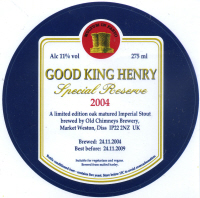 Old Chimneys Good King Henry Special Reserve Pale, crystal and wheat malt and roasted barley make up the grist, with Fuggles and Challenger hops. Vintage dated bottles have best before dates set five years later though it’s probably worth cellaring for longer if you’re lucky enough to get hold of several bottles.
My 2004 sample poured a near-black mahogany colour with a thin but persistent pinkish-brown head. A very heady aroma was rich and sweet with dark malt, blackcurrant fruit and a whiff of sherry-cask single malt whisky.
The palate is thick, potent and sweet with candied and fresh orange fruit, marzipan, subtle wood and claret-style “lead pencil” touches. I caught a very faint whiff of smoked ham, but overall the beer is much less smoky and roasty than most others in the same broad style.
A warming swallow leads to a very long finish with, sweetish sherry notes, faint wood adding texture to the background and tingling alcohol and hops.
The name, incidentally, refers not to a British royal but to an obscure green vegetable also known as “poor man’s asparagus”. If “poor man’s” implies second rate, it’s an inappropriate comparison, for this is an outstanding product that could proudly grace anyone’s table.
See next post for more strong beers.
Read more about these beers at ratebeer.com:
http://www.ratebeer.com/beer/old-chimneys-redshank-strong-ale/23458/
http://www.ratebeer.com/beer/old-chimneys-good-king-henry-special-reserve/67522/
First published in BEER November 2006 as part of a piece about beers stocked by Tesco supermarkets. See previous post for more Tesco beers.
ABV: 4.3 per cent
Origin: Crockham Hill, Kent, England
Website: www.westerhambrewery.co.uk
 As well as the Drinks Awards winners, Tesco has beers of interest on offer in its “local programme”, which covers 600 stores. The regional approach is particularly developed in Scotland, where Scottish-brewed beers are ousting nearly all the English speciality ales. As well as the Drinks Awards winners, Tesco has beers of interest on offer in its “local programme”, which covers 600 stores. The regional approach is particularly developed in Scotland, where Scottish-brewed beers are ousting nearly all the English speciality ales.
But even south of the border, a few unusual regional lines are popping up. My nearest Tesco currently offers this rather good best bitter from Crockham Hill on Kent’s attractive Greensand Ridge, about thirty miles away.
The Westerham Brewery was launched in 2004 at the National Trust’s Grange Farm, and uses yeast from the former Black Eagle Brewery in Westerham, a takeover casualty of what is now Carlsberg. Some of the beers use hops from the Trust’s Scotney Castle, but BB celebrates another nearby Trust property, Winston Churchill’s former home at Chartwell.
This is a clear amber beer brewed from Maris Otter pale and crystal malts, with a thin but smooth and persistent off-white head, and a fruity, spicy blackcurrant jelly aroma with roast and farmyard notes.
The palate is nicely malty and fruity but dry from the start, with lychee notes and rich resins from local Northdown and Whitbread Golding Variety hops. A light swallow leads to a piney finish with a dose of peppery bitterness over more juicy fruit.
The fact this tasty and full-bodied bitter makes so much of its local provenance can only be a good thing, and it’s great to see it on the shelves of such a behemoth as Tesco.
Read more about this beer at ratebeer.com: http://www.ratebeer.com/beer/westerham-british-bulldog-bb/36415/
|
Cask  This pioneering new book explains what makes cask beer so special, and explores its past, present and future. Order now from CAMRA Books. Read more here. This pioneering new book explains what makes cask beer so special, and explores its past, present and future. Order now from CAMRA Books. Read more here.
London’s Best Beer  The fully updated 3rd edition of my essential award-winning guide to London’s vibrant beer scene is available now from CAMRA Books. Read more here. The fully updated 3rd edition of my essential award-winning guide to London’s vibrant beer scene is available now from CAMRA Books. Read more here.
|

















